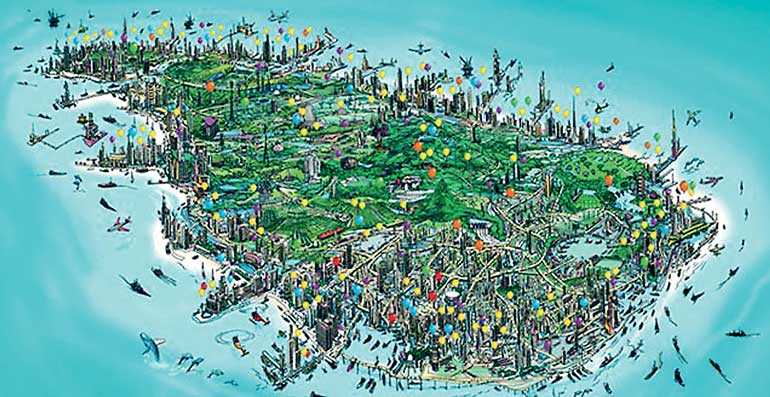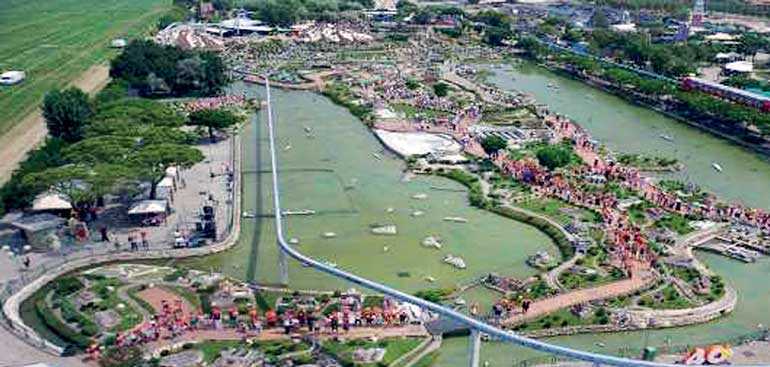Monday Mar 10, 2025
Monday Mar 10, 2025
Thursday, 11 October 2018 00:00 - - {{hitsCtrl.values.hits}}

First step: Mapping of Sri Lanka heritage landmarks
The representative for ICT4SIDS in the Indian Ocean Region, Vittorio Coco, on Tuesday announced the initiation and planning phase of the Minilanka Heritage Park, an ambitious, multi-stakeholder tourism project aimed at furthering Sri Lanka’s efforts to achieve the Sustainable Development Goals (SDGs) set out in the UN 2030 Agenda. The project will contribute to the fulfilment of SDGs 4, 12 and 17, through sustainable tourism.
Inspired by the 85,000-square metre, Italy-shaped Miniature Park in Rimini, Italy, The Minilanka Heritage Park will be built on a well accessible, countryside open space with a landscape design that will reflect the tear-drop shape of the island. The park is expected to become a top-rated international tourist attraction and the first-in-the-world to showcase unique miniature (1:25 scale) replicas of the country’s landmarks produced using 3D laser scanning drones flying over the original sites and 3D printers fed with filaments extracted from recycled plastic waste.
The park development will integrate a series of multipurpose playfields: Eco-certified bungalows for overnight guests, shopping and dining facilities all spread across a vibrant green environment. Completing the leisure experience for visitors will be a stretch of smart pavilions ordered to showcase different sustainability issues; i.e.: poverty, health, education, climate change, life on land and below water, etc. This is aimed at providing youth and adults with a learning experience platform (augmented and virtual reality, gamification and computer-aided strategic planning etc.), to explore the current progress of and eventually contribute their own next generation solutions towards fulfilling the Sustainable Development Goals in Sri Lanka.
The initial planning team of service providers and products suppliers associated and coordinated by ICT4SIDS for the Minilanka Heritage Park include Erik Rorsch, international expert on miniature cities and attraction parks, Christiaan Kruis, environmental designer (www.christiaankruis-arch.com), Protoprint, India, the producer of filaments for 3D printing from recycling plastic waste (www.socialseva.org/protoprint) and Thrimana, www.thrimana3dprinters.com, the only Sri Lankan company already achieving successful expertise and results in the forefront of 3D scanning and 3D printer manufacturing.
“Sri Lanka has 8 UNESCO World Heritage Sites and wonderful natural attractions but not too many people do know that. A miniature park is a great way to show Sri Lanka to the rest of the world all in one place. Visitors to Minilanka Heritage Park will be able to admire 50-100 models of important Sri Lanka buildings, heritage and nature sites, and the models will be made with modern technology, using for-the-first-time, recycled plastic waste. That’s sustainability! Around the model park, there will be themed pavilions about history, energy, mobility, hospitality, water, food and the future. It’s going to be half-a-day of great fun for everyone!” commented Erik Rorsch, Creative Director for the Miniature City.
“Thrimana is the leading 3D Printing brand in Sri Lanka and has the largest market share. We have conducted several research projects to enhance our technology, in addition to exploring the possibilities of applying 3D printing to other fields. One of our projects was to identify the capability of applying 3D scanning and 3D printing for preserving historical sites. We are proud to say that we are the only organisation which has conducted such a programme in Sri Lanka. So we are really happy to partner with this initiative and to support its objectives,” said Rajitha de Silva, CEO of Thrimana speaking about their engagement in the project.
Preliminary plans have already been laid down on the drawing board to attract potential investors, with a commitment to produce a full feasibility study within a period of maximum 8 months, and a master plan to create this one-of-a-kind theme park in one of the nine Provinces of Sri Lanka.
“It’s a lucrative investment prospect for local investors and an opportunity for domestic stakeholders to contribute to Sri Lanka’s journey to fulfil the SDGS, through bolstering sustainable tourism. By introducing the vision of an eco-smart theme park project in Sri Lanka, ICT4SIDS aims to challenge the tourism industry to support innovative solutions in the preservation of Sri Lanka’s heritage and conservation of the environment. The Minilanka Heritage Park is also envisioned as a powerful tool to create and enhance new cultural, economic and social opportunities in the tourism industry for younger generations. It will also become a catalyst for Sri Lanka implementation of the Youth 2030 Strategy launched by the Secretary General of United Nations in September 2018 to achieve better education, skills development and empowerment of young people worldwide,” added Vittorio Coco, South Asia Representative for ICT4SIDS.
ITC4SIDS is a UN Partnership founded and directed by Professor Umar Amjad, headquartered in the University of Harrisburg, Pennsylvania, USA, devoted to advance the Sustainable Development Goals in Small Islands Developing States through Information and Communication Technologies. Professor Amjad and his team of graduated engineers have developed so far several ICT-based pilot projects to benefit youth and women in underserved and remote area of the world with a vision to set up a global network of smart hubs for smart communities.
For further information please visit www.ict4sids.com or call Vittorio Coco +94771300108.

Great outdoors: Italy-shaped Miniature Park, in Rimini, Italy
Discover Kapruka, the leading online shopping platform in Sri Lanka, where you can conveniently send Gifts and Flowers to your loved ones for any event including Valentine ’s Day. Explore a wide range of popular Shopping Categories on Kapruka, including Toys, Groceries, Electronics, Birthday Cakes, Fruits, Chocolates, Flower Bouquets, Clothing, Watches, Lingerie, Gift Sets and Jewellery. Also if you’re interested in selling with Kapruka, Partner Central by Kapruka is the best solution to start with. Moreover, through Kapruka Global Shop, you can also enjoy the convenience of purchasing products from renowned platforms like Amazon and eBay and have them delivered to Sri Lanka.
Discover Kapruka, the leading online shopping platform in Sri Lanka, where you can conveniently send Gifts and Flowers to your loved ones for any event including Valentine ’s Day. Explore a wide range of popular Shopping Categories on Kapruka, including Toys, Groceries, Electronics, Birthday Cakes, Fruits, Chocolates, Flower Bouquets, Clothing, Watches, Lingerie, Gift Sets and Jewellery. Also if you’re interested in selling with Kapruka, Partner Central by Kapruka is the best solution to start with. Moreover, through Kapruka Global Shop, you can also enjoy the convenience of purchasing products from renowned platforms like Amazon and eBay and have them delivered to Sri Lanka.